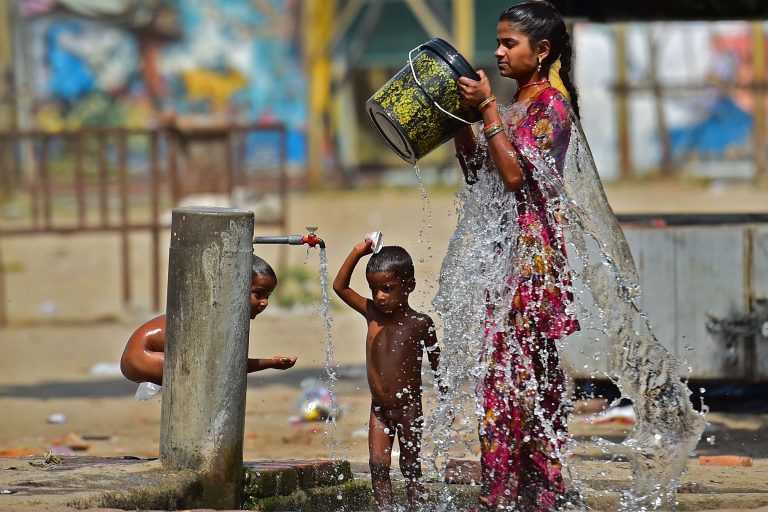India has been baking under an unprecedented heat wave with numerous regions in the country recording temperatures well in excess of 40°C (104° F) for days on end with little relief in sight. The heat has prompted millions to take refuge indoors while crops fail and demand for electricity soars.
The Indian Meteorological Department (IMD) expects the heat to abate somewhat over New Delhi come Monday however numerous other regions are being told to brace for continued heatwave conditions in the coming days.
According to the IMD on Sunday, May 1, temperatures in the range of 43-47°C (109.4°F – 116.6° F) covered most parts of Rajasthan, Vidarbha, Telangana, some parts of Haryana, Delhi, West Madhya Pradesh, pockets of East Madhya Pradesh, morth Madhya Maharashtra, Marathwada, Gujarat, Jharkhand, Rayalaseema and Chhattisgarh, the Times of India reported.
In addition, temperatures hovering between 40°- 42°C (104°F – 107.6° F) were observed in the northern regions of Odisha and Coastal Andhra Pradesh.
The IMD said that in most parts of India the maximum temperature exceeded normal temperatures for the time of year by approximately 5°C including in Jammu, Kashmir, Ladakh, Gilgit-Baltistan and Muzaffarabad.
Success
You are now signed up for our newsletter
Success
Check your email to complete sign up
In India’s Rajasthan’s Churu region temperatures hit a record 44.8°C (112.64° F).
Heatwaves are common in India, particularly in the months of May and June, however summer began early this year with temperatures soaring beginning in March. The “average maximum temperatures in the month were the highest in 122 years,” the BBC reported.
Heatwave threatens India’s wheat output
Farmers say the unexpected temperature spikes are taking a toll on their wheat harvest, an issue that could potentially have global consequences given supply disruptions due to the war in Ukraine.
Following five consecutive years of record harvests the sudden rise in temperatures, beginning in mid-March, threatens to cut crop yields considerably.
India is the world’s second largest producer of grains.
In mid-February, approximately a month before the recent heatwave, India was set to produce an all-time high of 111.32 million tons of the grain, an increase from the previous year’s 109.59 million tons.
While the government is yet to formally revise its production estimates, an official note, seen by Reuters, said the output could fall to 105 million tons this year.
“Loss of production of wheat, all India basis, more or less stands around 6%, on account of shrivelling of wheat grains around 20% due to terminal heat and heat waves,” Reuters reported.
According to a senior government official who monitors planting and harvests, “it’s a little early to understand the extent of the crop loss.” The official declined to provide his name as he was not authorized to speak to the media.
“Based on the production estimates issued by the government in February, we could have easily exported much more than 12 million tonnes, but it now looks like we’ll be exporting around 10 million tonnes,” he said, according to Reuters.
He believes that despite the heat, India’s wheat exports could easily cross last year’s shipments, however others are more pessimistic, estimating a 10 percent drop in output.
“Dwindling supplies in spot markets are indicating a bigger drop in the production. I think production could be down 10% to around 100 million tonnes,” said a head of an Indian global trading firm, who also declined to be named.
He expects the Indian government may restrict exports if production sinks to this level, he said.
Electricity demand skyrockets
The early summer temperatures are driving record demand for electricity in the country as Indians turn up the air conditioning to take refuge from the deadly heat.
“Power demand grew 13.2 percent to 135.4 billion kilowatt hours (kWh), as the electricity requirement in the north grew between 16 percent and 75 percent,” Garavi Gujarat reported.
Demand for electricity is expected to grow as the high temperatures persist. The demand has triggered the worst power crisis in the country in more than six years.
The unprecedented electricity demand resulted in widespread power cuts in April of this year, as providers struggled to meet clients needs while coal supplies dwindled. Supply fell short of demand by 2.41 billion units, or 1.8 per cent, the worst since October 2015.
In Delhi, demand for electricity rose an astonishing 42 percent in April, with northern states such as Punjab and Rajasthan experiencing electricity demand soar by 36 percent and 28 percent respectively, according to government data.
In the small hilly state of Sikkim in the northeast the heat led to a 74.7 percent rise in electricity use.
In the northern states of Haryana and Uttar Pradesh, as well as Jharkhand in the east, demand for electricity rose by more than 25 percent.
A total of seven states, including Andhra Pradesh in the south, have suffered their worst power cuts since 2016.
As coal inventories deplete India is likely to face more power cuts. Coal inventories are at their lowest pre-summer levels in at least nine years despite state-run Coal India, which contributes up to 80 percent of India’s coal output, ramping up production by more than 27 percent.

















